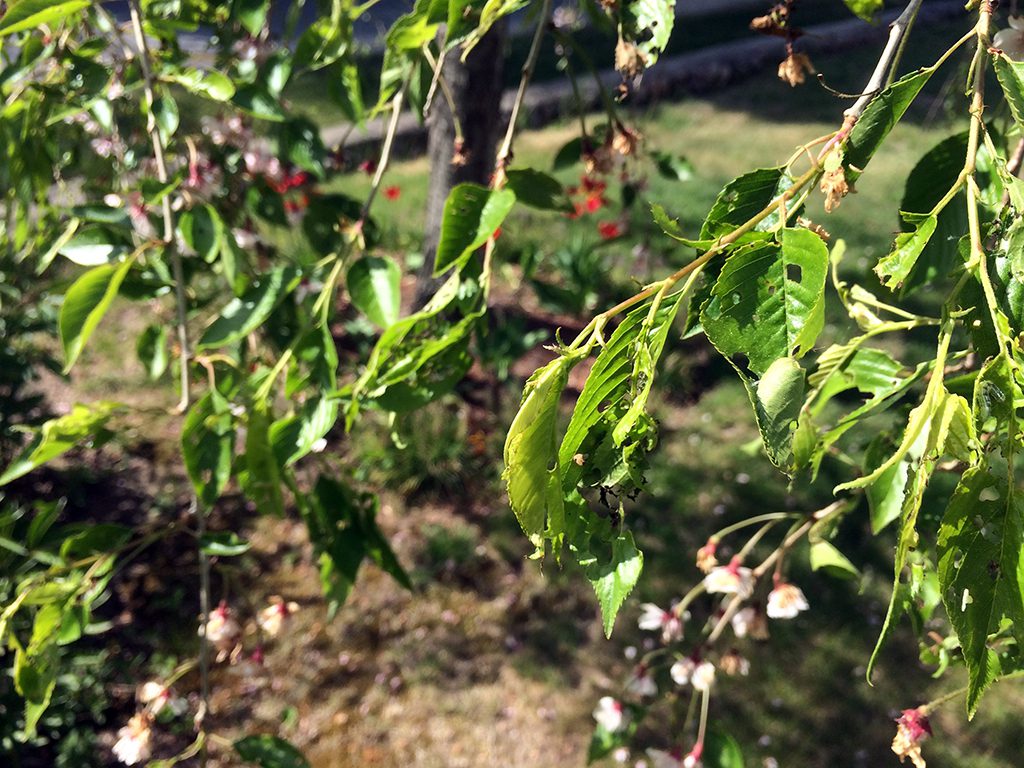Winter Moth Larvae Are Here!
Winter Moth Larvae Are Here!
If you haven’t looked closely at your maples, birches, crabapples, weeping cherries and roses in the past two weeks you might be missing the fact that they are being eaten. Even as the these trees and shrubs are just breaking dormancy, if you live in S.E. Massachusetts you are likely to see tiny holes in the leaves on close inspection. The winter moth larvae, tiny and green, are chomping away at your plants.
They are called winter moth because the adult moths fly and mate in late-November and December. The females lay eggs on the bark of trees and those eggs hatch in the early spring, typically in April depending on the weather. The larvae can sail from tree to tree on webs, and initially their damage goes unnoticed because the leaves are small and they are taking tiny bites. But if you let them continue to feast on your plants, you’ll find that once the foliage is more mature it’s also completely shredded. Winter moth larvae can defoliate trees just at the time when they should be greening up and becoming beautiful.
Spray asap with Spinosad. (We sell this in several forms from two companies, Captain Jack’s and Monterey) and use some Turbo spreader-sticker as well to help the spinosad stick on the foliage. The only caution is not to spray on flowering plants when bees are foraging…when dried, spinosad is fine for bees, but if the wet product hits the bees they get confused and don’t make it back to hives and homes. So just avoid spraying when your crabapple is flowering, for example.
2023 UPDATE: Winter moth larvae are no longer a huge problem on Cape Cod. Watch your plants in the spring for signs of a great deal of damage or defoliation, but it’s likely that we no longer need to treat for these larvae.

12 Comments
Leave a Comment
Subscribe To Our Newsletter
Sign up for our weekly email about sales and events.

What is the best way to manage Spider Mites in cypress trees?
First be sure you really have spider mites – an accurate diagnosis is very important, because to get rid of mites you need a miticide, not just any insecticide. Spray the miticide according to directions. (We carry miticides by Bonide – come into the store and talk to us.)
I did not know winter moths eat roses too. A few days ago I sprayed my roses with Bayer disease and insect control. Wil this take care of the winter moths? Or do I need to use captain jacks dead bug on them? If I need to spay again with the oil can I do it right away or do I have to wait since I just spayed them with bayer product?
Rhonda – spray with Spinosad (Captain Jacks) asap.
I sprayed the maples two weeks ago with Spinosad and spreader-sticker. Do I need to spray again? And is it safe to do so at SUNSET? Thanks.
Barbara,
Yes, spray again right away because the maple leaves are now larger than they were when you sprayed before. On Maples now you can spray in the day because they are not blooming. (They bloom before the leaves come out.)
I just planted some knockout roses. They are pretty small and look very healthy with no evidence of Catapillar’s. Should I spray them now? I don’t want to harm them but don’t want them to be eaten either! Thx!
Beth,
Spray the roses now – Spinosad will do no harm and they will be protected from both winter moth larvae (eating now) and the rose-slug budworm, which will be feeding in June.
Will Bayer advanced dual action rose and Insect killer work on the roses? thank you
A systemic such as this product is way too slow – your roses would be defoliated before it kicked in. Use spinosad asap.
I have been watching my trees getting damaged by these pests for several years.Here in my area of little Compton,r.i., Ithink we are having a reprieve this season.Very few catapillars as of May15I have a lot of damage from past years and a year off is a blessing I hope I am correct.
James,
I hope you are right, but look carefully. Right now the larvae are very, very small and they commonly roll up in the leaf to hide themselves. Most people are assuming their trees are OK at this point (even landscape professionals!) but in reality this is far from the case. If they were my trees I would protect them with an application of spinosad, with Turbo in the sprayer to help it stick. Even covering the lower 15′ with a hose-end sprayer set on “stream” helps tremendously.